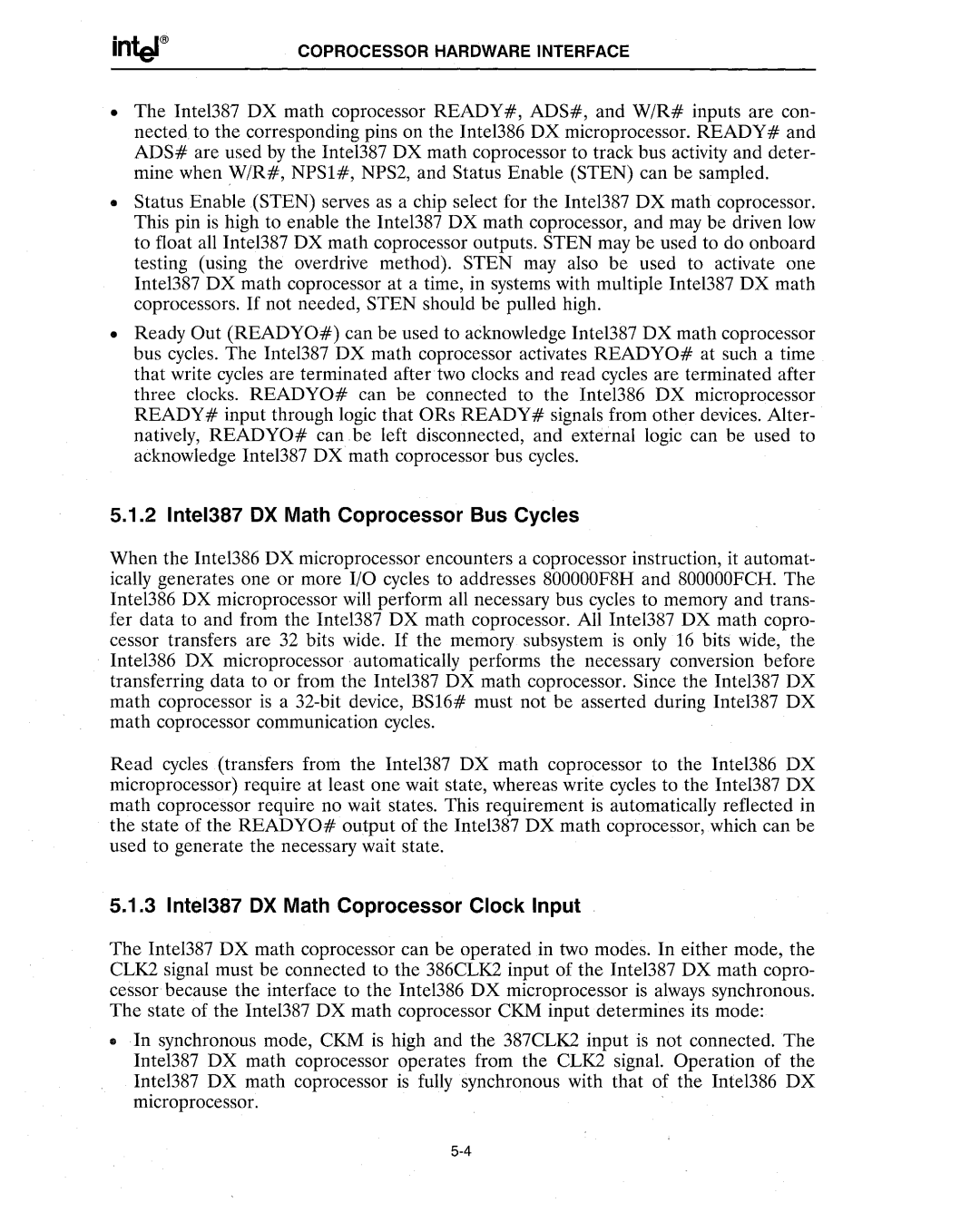
COPROCESSOR HARDWARE INTERFACE
•The Intel387 DX math coprocessor READY#, ADS#, and W/R# inputs are con- nected. to the corresponding pins on the Intel386 DX microprocessor. READY# and ADS# are used by the Inte1387 DX math coprocessor to track bus activity and deter- mine when W/R#, NPS1#, NPS2, and Status Enable (STEN) can be sampled.
•Status Enable (STEN) serves as a chip select for the Inte1387 DX math coprocessor. This pin is high to enable the Intel387 DX math coprocessor, and may be driven low to float all Inte1387 DX math coprocessor outputs. STEN may be used to do onboard testing (using the overdrive method). STEN may also be used to activate one Inte1387 DX math coprocessor at a time, in systems with multiple Inte1387 DX math coprocessors. If not needed, STEN should be pulled high.
•Ready Out (READYO#) can be used to acknowledge Intel387 DX math coprocessor bus cycles. The Intel387 DX math coprocessor activates READYO# at such a time that write cycles are terminated after two clocks and read cycles are terminated after three clocks. READYO# can be connected to the Inte1386 DX microprocessor READY# input through logic that ORs READY# signals from other devices. Alter- natively, READYO# can .be left disconnected, and external logic can be used to acknowledge Inte1387 DX math coprocessor bus cycles.
5.1.2Intel387 OX Math Coprocessor Bus Cycles
When the Inte1386 DX microprocessor encounters a coprocessor instruction, it automat- ically generates one or more I/O cycles to addresses 800000F8H and 800000FCH. The Intel386 DX microprocessor will perform all necessary bus cycles to memory and trans- fer data to and from the Inte1387 DX math coprocessor. All Intel387 DX math copro- cessor transfers are 32 bits wide. If the memory subsystem is only 16 bits wide, the Intel386 OX microprocessor automatically performs the necessary conversion before transferring data to or from the Intel387 DX math coprocessor. Since the Intel387 DX math coprocessor is a
Read cycles (transfers from the Intel387 DX math coprocessor to the Intel386 DX microprocessor) require at least one wait state, whereas write cycles to the Intel387 DX math coprocessor require no wait states. This requirement is automatically reflected in the state of the READYO# output of the Intel387 DX math coprocessor, which can be used to generate the necessary wait state.
5.1.3 Intel387 OX Math Coprocessor Clock Input
The Intel387 DX math coprocessor can be operated in two modes. In either mode, the CLK2 signal must be connected to the 386CLK2 input of the Intel387 DX math copro- cessor because the interface to the Intel386 DX microprocessor is always synchronous. The state of the Intel387 DX math coprocessor CKM input determines its mode:
•In synchronous mode, CKM is high and the 387CLK2 input is not connected. The Intel387 DX math coprocessor operates from the CLK2 signal. Operation of the Intel387 DX math coprocessor is fully synchronous with that of the Intel386 DX microprocessor.
